Conversations around climate change have sort of become a sing-along anthem in many jurisdictions around the world. The recent COP 28 meeting was primarily about climate change and the action that the world needs to take collectively. However, while governments continue to talk, establish conventions, and introduce policies, citizens across the globe need to realise that they too have an equally important role to play.
But the problem is worse than people think. According to the WHO, there are 3.6 billion people already living in places that are highly susceptible to climate change. A recent report in the Washington Post shows that the world is set to pass a catastrophic warming threshold by the 2030s. The report was based on findings by the United Nations Intergovernmental Panel on Climate Change, which revealed that the world will surpass its warming limit of 1.5 degrees Celsius, leading to climate disasters that will be too severe for people to adapt.
Advertisement
When a person is obese, or at risk of cancer, diabetes, or heart disease, they make crucial lifestyle changes. In the same vein, making lifestyle changes can be a crucial step towards averting the gloomy future that climate change portends if no action is taken. One of the smartest decisions a person can take is future-proofing their lifestyle by making climate-friendly choices, such as embracing the electric vehicle.
EV adoption, modernity, and the fight for earth
The simple definition of future-proofing connotes a situation where an individual anticipates a certain future and adopts or picks up certain lifestyle choices or methods to reduce or minimise the shocks or effects of that predicted future. In this sense, it means anticipating the damage that carbon emissions will cause in the future and taking steps to reduce them. Globally, it is said that transport is the biggest contributor to emissions, between 28 and 30%. Therefore, transitioning to zero-emission transport alternatives should be the ideal future-proofing.
The world needs to reduce its carbon emissions by 45% in 2030 and achieve Net Zero emissions by 2050, according to the UN. But beyond international and bilateral engagements and meetings, everyone has a responsibility to future-proof their lifestyles. The adoption of EVs on a quicker scale can mitigate the worsening effects of climate change. For this to happen, people need to be intentional about climate action when they shop for cars or other vehicles.
On the other hand, affordability is a huge factor. This is why incentives are important. Government-backed incentives can help bring down the cost of production and consequently reduce the selling price in order to make EVs more affordable for the people. There is a need to transform the EV subsector from a perceived luxury segment to a commercial segment.
In India, for instance, EV sales have gone up significantly over the last few years. EV passenger vehicle sales are estimated to surpass 2.3% of all passenger vehicle sales as of December 2023, way above 0.48% recorded in 2021. With new and improved ranges, commercial and affordable releases under $10,000, and more practical options flooding the Indian market, one expects that EV adoption will be way more than the current level.
Bridging the EV gap for the future
The current incentives by the Indian government are commendable. The Production-linked Incentive (PLI) for EV makers, the FAME programme, as well as direct subsidies offered to EV buyers are all important steps towards encouraging EV adoption in the country for a preferred future. The incentives for battery charging companies known as FAME are broad, including the reduction of duty on components like nickel ore, nickel oxide, and ferro nickel to 0% in many cases.
Conversely, subsidy was recently increased through the FAME-2 programme which saw it move from INR 10,000 to INR 15,000. What is left is for Indians to take advantage of these initiatives, both on the supply and demand sides, buoyed by a desire to secure the world for future generations, and switch allegiance from harmful fossil fuels to clean and safe battery-powered vehicles.











